What is dribble penetration in basketball
Dribble penetration consists of offensive action that occurs when a player in possession of the basketball near the perimeter areas of the court dribbles between certain gaps of the defense with the primary objective of getting to the basket.
In other words, the player with the ball utilizes the skill of dribbling, especially with different types of dribble moves, to penetrate or pierce through one or more defenders in an effort to get the basketball as close to the rim as possible.
Moreover, dribble penetration could also be referred to as attacking the rim or dribble drive action.
What is the importance of offensive dribble penetration
Dribble penetration is important, particularly on offense, because it is one of the primary methods for causing defensive breakdowns. This, in turn, could lead to multiple scoring opportunities for the offensive team.
Generally speaking, if an offensive player with the ball is able to execute dribble penetration by beating the on-ball defender with a dribble move or some other offensive tactic, then additional strong side or weak side defenders will be influenced to implement different types of defensive tactics to mitigate that dribble penetration.
However, this could create a possible vulnerability in the defense, in which one or more additional offensive players could become open to receiving the ball from the player that performed the dribble penetration.
When that occurs, it could lead to open jump shots, particularly behind the three-point line or in some instances, close-range shots such as a layup near the basket; both of which are beneficial to the offense and detrimental to the defense.
What are basic examples of offensive dribble penetration
Example 1
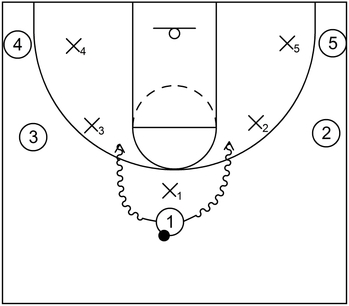
This is an example of offensive dribble penetration when the ball is at the top. In this instance, 1 could dribble penetrate into the gap between X1 at the top and X2 near the right side wing.
Conversely, 1 could also dribble penetrate into the gap between X1 at the top and X3 near the left side wing.
Example 2
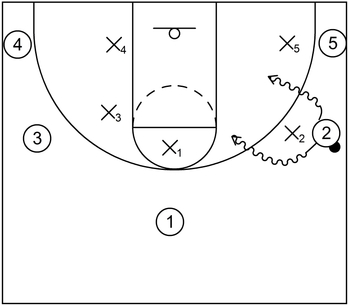
This is an example of offensive dribble penetration when the ball is on the wing. For this case, 2 could dribble penetrate into the gap between X2 on the wing and X1 at the top, which is also typically known as driving to the middle.
Furthermore, 2 could dribble penetrate into the gap between X2 on the wing and X5 near the corner, which is also referred to as attacking the baseline.
Example 3

This is an example of offensive dribble penetration when the ball is in the corner. To demonstrate, 5 could dribble penetrate into the gap between X5 in the corner and X2 near the wing.
On the other hand, 5 could also dribble penetrate between X5 in the corner and the baseline itself.
Example 4
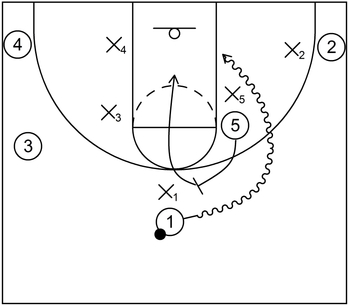
This is an example of offensive dribble penetration which also includes basic pick and roll action at the top. To start, 1 dribbles toward the basket via the on-ball screen by 5. Additionally, 5 rolls to the basket after setting the screen.
Example 5
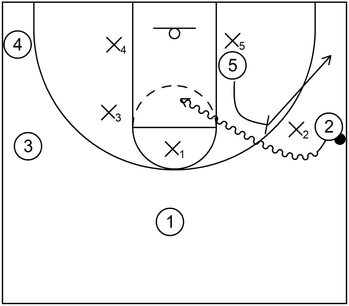
This is an example of offensive dribble penetration which also includes simple pick and pop action near the wing. To demonstrate, 2 attacks the basket with middle dribble penetration by way of the on-ball screen set by 5.
Moreover, after setting the screen, 5 pops to the empty right side corner.
What are examples of defensive tactics that could be used against offensive dribble penetration
Example 1
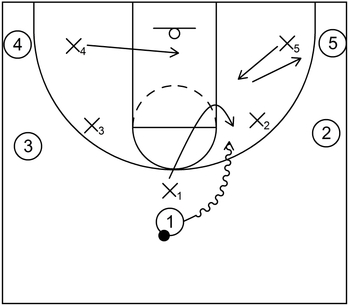
This is an example of a possible defensive tactic that could be implemented against offensive dribble penetration from the top. To start, X1 gets beat and dribble penetration occurs near the right side.
After that, X4 could step into the paint to protect the basket while X5 could stunt towards the ball and quickly recover back to 5. The purpose of the stunt and recover tactic is to influence 1 to pass the ball to 5.
Moreover, the stunt tactic could potentially slow down the dribble action of 1, which would then give X1 enough time to sprint back in front of 1.
Example 2
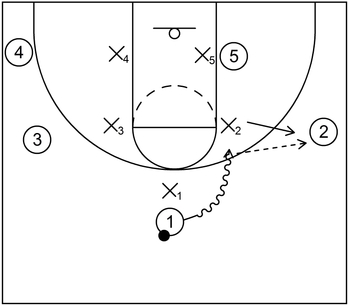
This is an example of a defensive tactic reminiscent of the pack line defense to limit or prevent dribble penetration. For this demonstration, X2 and X3 sag off their respective assignments by standing near the high post elbows while X1 implements on-ball pressure defense.
Afterwards, if 1 is able to get dribble penetration, X2 is already standing near the gap to slow down that penetration. Even if 2 receives the ball, X2 could still have enough time to closeout and prevent a potential uncontested three-point shot.
Also, it should be noted for this particular example, the defensive team presumes that 2 and 3 are non-shooters and/or the defensive team does not mind allowing perimeter shooting if that is the trade-off for limited or no dribble penetration at all.
Example 3

This is an example of a defensive tactic, generally known as protecting the nail, when the ball is on the wing. To demonstrate, X1 drops back near the center of the high post area.
Next, if 2 decides to dribble penetrate into the gap between the wing and the top, then X1 could stunt at the ball to slow down the dribble penetration. When that occurs, it could give X2 enough time to get back in front of the ball.
Afterwards, X1 could recover back to the center of the high post area. Furthermore, the stunt and recover tactic could cause 1 to receive a pass executed by 2.
If that occurs, it is a plus for the defensive team because then, not only did the defense completely stop the initial penetration, but they also influenced the offensive player to pass the ball away from the basket.
Example 4
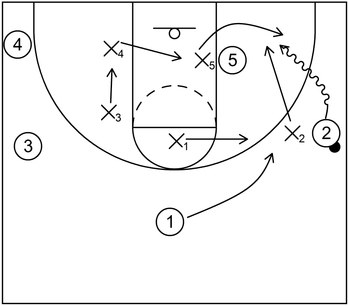
This is an example of a defensive tactic when the ball is on the wing. To begin, 2 attempts to dribble penetrate in the gap between the wing and the empty corner near the baseline.
When that occurs, X5 could step towards the ball to slow down the dribble penetration. Also, as that happens, X4 could slide into the paint to guard player 5 near the right side low post while X3 drops back to stand in the gap between 3 and 4.
Next, as X5 limits the dribble penetration, X2 could execute a baseline trap alongside X5. Moreover, 1 would most likely cut towards the wing to provide 2 with a viable passing option.
At the same time, X1 could attempt to prevent that passing option by executing denial defense near the wing.
Example 5

This is an example of a defensive tactic, typically referred to as hedging, when the ball is at the top with pick and roll action. To start, 1 attempts to dribble penetrate between the gap at the top and the wing via the on-ball screen set by 5.
However, X5 hedges the dribble penetration by stepping into the pathway of 1 while X1 fights over the top of the on-ball screen to get back in front of 1.
At the same time, if 5 rolls to the basket, then X3 could tag 5 to slow down the roll action. Afterwards, X5 could recover back to 5 while X3 cuts back to the weak side help position near the high post elbow.
Example 6
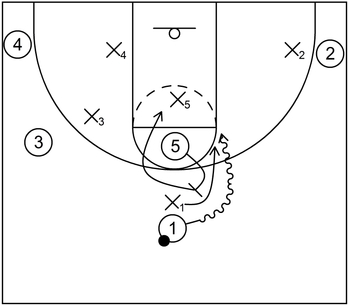
This is an example of a defensive tactic, known as drop coverage, when the ball is at the top with pick and roll action. To demonstrate, 1 dribble penetrates into the gap between the top and the right side wing via the on-ball screen set by 5.
However, X5 is able to limit and contain that dribble penetration by staying below the free throw line near the half circle. This allows X1 enough time to fight through the on-ball screen and recover to 1.
Furthermore, if 5 tries to roll to the basket, then X5 is already in a good position to prevent that roll action as well. Essentially, the drop coverage seeks to limit the dribble penetration and cause the roll action to become ineffective.
The main scoring option for the defense is usually the mid-range jump shot but if the defensive team implements the drop coverage tactic, it is typically assumed that 1 as well as 5 are non-shooters.
Example 7

This is an example of a defensive tactic, referred to as ice defense, when the ball is on the wing with pick and roll action. To start, 1 receives an on-ball screen set by 5.
However, X1 takes away the screen by sliding on top of it. This essentially takes away middle dribble penetration and instead, forces 1 to reject the screen and dribble towards the baseline.
When that occurs, X5 limits any baseline dribble penetration by containing the ball until X1 could recover. Also, for this case, if 5 rolls to the basket, then X5 could recover back to 5.
Example 8
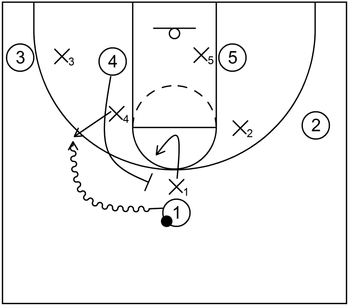
This is an example of a defensive tactic, generally known as switching, when the ball is at the top. To demonstrate, 1 attempts to dribble penetrate between the top and the left side wing via the on-ball screen set by 4. However, X4 prevents the dribble penetration by simply switching onto 1 while X1 switches onto 4.